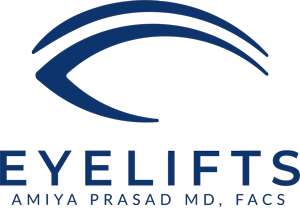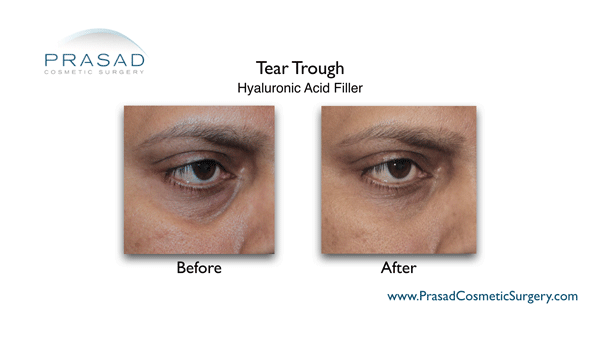Surgical and Non-Surgical Hollow Eyes Treatments
What Causes Hollow Eyes?
Hollow eyes, also referred to as deep tear troughs, can be a genetic condition, part of facial aging where volume under the eyes is lost, or a result from overly aggressive lower eyelid surgery (blepharoplasty). Too much fat may have been removed in trying to reduce eye bags; or fat repositioning where fat causing eye bags is moved to a hollow area, but the fat is reabsorbed by the body or shifts elsewhere creating a hollow look.
Hollow Eyes Treatments:
Hyaluronic Acid Fillers for Under Eye Hollows
A hyaluronic acid filler like Restylane or Juvederm is the most popular treatment for hollow eyes. Hyaluronic acid is a naturally occurring substance in the body, so it is safe for cosmetic use and around the eyes. Both Restylane and Juvederm have a thickness and consistency appropriate for the under eye area, and cannot be seen through thin, translucent eyelid skin. These fillers can be molded to customize the contour and shape under the eyelids. Hyaluronic acid fillers do not require a blood supply, so their position is more fixed and predictable.
In cases where too much of a hyaluronic acid filler has been applied, it can be easily and safely dissolved with the enzyme hyaluronidase. The ease of dissolution is one of the advantages of hyaluronic acid fillers. However, it is still easier to add filler when needed rather than dissolving all of it. For this reason, Dr. Prasad recommends that initial filler application should be conservative, with the option to add more once it settles out. It normally takes about two weeks for a hyaluronic acid filler to settle after initial application.
The drawback to hyaluronic acid cosmetic fillers is that they need to be maintained. Depending the individual and type of filler used, hyaluronic acid fillers may need to be reapplied in about year’s time.
Platelet-Rich Plasma (PRP) Combined with a Hyaluronic Acid Filler
Dr. Prasad is a pioneer in using platelet-rich plasma (PRP) for cosmetic use. Platelet-rich plasma is by product of your own blood. Blood is taken like a routine blood test, and spun with a centrifuge. The clear yellow serum that is separated from heavier red blood cells is platelet-rich plasma. PRP has long been used to speed healing in orthopedic and dental surgery. Applying PRP’s multitude of wound healing and regenerative factors to the skin has resulted in improved skin thickness, texture, color, and luster.
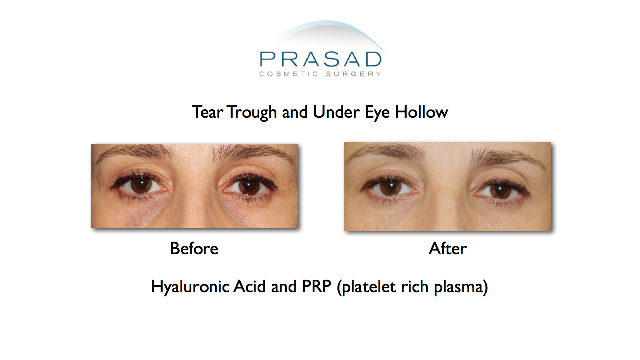
Combining a hyaluronic acid filler with platelet-rich plasma (PRP) fills the hollow tear trough, improves the quality of the skin to reduce dark circles, and also extends the effective life of both materials
Sunken eyes is often accompanied by dark circles, which can be caused by pigmentation issues, iron deposits, lack of blood supply, or general skin thinness. Platelet-rich plasma’s healing and growth factors can stimulate production of collagen and increase blood flow to the treated area, makes translucent skin is made healthier and thicker, so less can be seen through it. Increases collagen and blood supply gives the skin better texture and healthier color rather than dark pigmentation or iron deposits. Along with the added volume from the hyaluronic acid filler, eyes look brighter, less tired, and more vibrant.
Increased Benefits and Longevity of the PRP+Filler Combination
The combination of platelet-rich plasma with a filler has a synergistic effect: Volume is improved in hollow areas through the filler, and the quality and health of skin under your eyes is improved with platelet-rich plasma. The effective longevity of both materials are also extended, so less maintenance and re-application of this treatment is needed.
As PRP does improve skin health and skin quality, the improved health of the skin is sustained (under normal conditions), even between treatments. The combined approach makes up for the limitations of each material: PRP can improve skin quality, thickness and generates collagen, but adds little volume; while fillers provide volume, they don’t change the condition of the skin.
Combining Laser Skin Resurfacing and Additional Collagen Stimulation
A third treatment can be added to combination to generate additional collagen, fractional CO2 laser. Fractional CO2 laser is primarily used to resurface the skin for wrinkle treatment, but wrinkles are often an issue caused by diminished skin quality. Fractional CO2 laser improves the appearance of wrinkles by stimulating collagen production through heat.
However, overuse of fractional CO2 laser can lead to diminished skin quality by thinning the skin through excessive heat treatment. However, when fractional CO2 laser is combined or followed by PRP treatment, collagen stimulation is done by two separate treatments, and PRP can be used to help heal the skin following heat treatment.
PRP and fractional CO2 provides better skin quality and wrinkle treatment than either treatment done alone, and the addition of a filler helps to even the contour of the eyes.
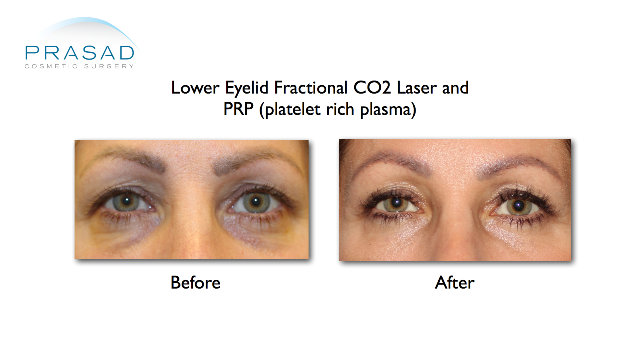
Hollowness, pigmentation, and wrinkles are treated with fractional CO2 laser and platelet-rich plasma (PRP), combining two collagen-stimulating methods for smooth, healthy results and thicker skin.
Tear Trough Implants
Tear trough implants can add permanent volume to fill hollow eyes, so maintenance filler treatments are unnecessary. Tear trough implants are made of silicone, a soft, rubber-type material. It is placed behind the eyelid skin through an internal incision, so no external incision is made and there is no visible scar.
The tear trough implant is placed over the bone under the eyelid. The procedure is done with local anesthesia with LITE™ sedation to relax the patient. Recovery for this type of surgery is about a week since healing is faster with local anesthesia as opposed to general anesthesia.
While the implant adds fullness and contour to the hollow area, it does not change the position of the lower eyelids, or the shape of the eyes.
Tear trough implant surgery is a highly specialized procedure. Eyelid specialist doctors like Dr. Prasad who have extensive experience in the transconjunctival approach (from the behind the lower eyelid) of eyelid surgery are best trained for this procedure.
Fat Transferring/ Fat Grafting
Fat Placement is Not Advised for Under Eye Hollows
If the loss of fat causes hollow eyes, then many conclude that transferring fat from another area of the body is good way to restore volume. Some surgeons do advocate fat transfer in the under eye area to restore or add volume, but Dr. Prasad is strongly against this practice because of the nature of fat and eyelid skin.
Eyelid skin in the thinnest skin of the body at about 0.5mm thick, which can make the skin translucent in some people. Thin eyelid skin can reveal what is beneath the skin. Fat, especially when removed from its original blood supply, is highly unpredictable, and can become more irregular and lumpy the longer it out of a blood supply.
Even when transferred to an area with a blood supply, transferred fat may not take.
It is also important to note that reversing a fat transfer is a complex and expensive procedure.
Fat Transfer for Upper Eye Hollowness
Fat transfers can be performed in areas of the face with thicker skin, such as the sub-brow area above the upper eyelids. This area may have hollowed if excessive fat was excised in aggressive Asian double eyelid surgery. It is important to note that for any fat grafting procedure that 30-70% of fat can be reabsorbed by the body, so needing a follow up procedure is common.
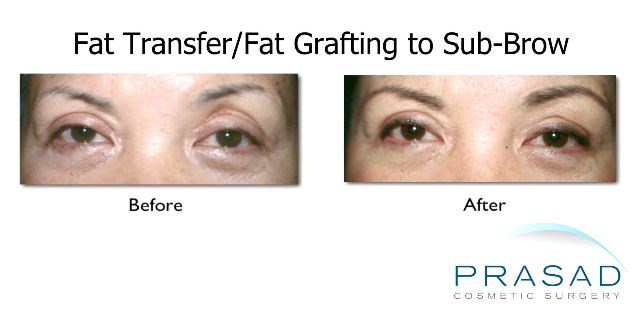
Fat transfer/ fat grafting can be done on the thicker skin of the sub brow to correct volume loss in the hollow, arched area above the upper eyelid.
Hyaluronic Acid Fillers for Upper Eyelid Hollowing
A cosmetic filler with Restylane or Juvederm’s consistency can be applied to the upper eye area. This is also the treatment for cases of too much soft tissue was incorrectly removed by a non-specialist eyelid surgeon.
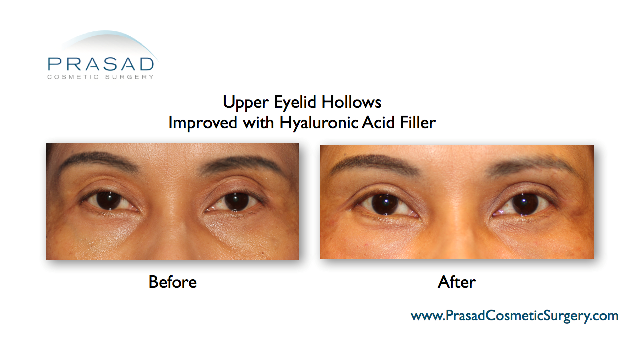
Upper eyelids were hollowed from previous surgery when too much fat was removed. Hyaluronic acid fillers like Restylane or Juvederm are more appropriate in the thin skin of the upper eyelids.
View upper eyelid filler before and after photos
Hollow Eyes Treatment in Manhattan NYC and Long Island, New York
Dr. Amiya Prasad is a Board-certified cosmetic surgeon and a Fellowship-trained oculofacial plastic surgeon with over 25 years of experience. He is known for his expertise in eyelid treatments and natural-looking results. As a pioneer in using platelet-rich plasma (PRP) for cosmetic use, Dr. Prasad combines advanced techniques with personalized care, making him a trusted authority in eyelid rejuvenation.
Your eyes are the focal point of your face, and among the most delicate areas of your body. The success of eyelid procedures is measured in millimeters. To ensure proper diagnosis and care, trust your eyes to a cosmetic eyelid specialist like Dr. Prasad. Our lines are open 24/7 in Manhattan at (212) 265-8877 or Garden City, Long Island at (516) 742-4636, or fill out the contact form below.
Post Reviewed by: Dr. Amiya Prasad
